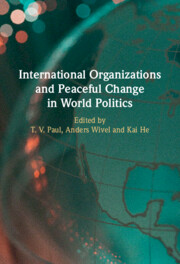Book contents
- International Organizations and Peaceful Change in World Politics
- International Organizations and Peaceful Change in World Politics
- Copyright page
- Contents
- Figures
- Tables
- Contributors
- Acknowledgments
- Part I Introduction
- Part II Theory
- 2 Great Power Management, International Organizations, and the Promotion of Peaceful Change: 1815 to the Present
- 3 Liberalism, Institutional Statecraft, and International Order
- 4 Constructivism, International Organizations, and Peaceful Change
- 5 When Do Rational IGOs Promote Peaceful Change?
- 6 Beyond the Pax Americana
- Part III Practice
- Part IV Conclusions
- Index
3 - Liberalism, Institutional Statecraft, and International Order
from Part II - Theory
Published online by Cambridge University Press: 30 January 2025
- International Organizations and Peaceful Change in World Politics
- International Organizations and Peaceful Change in World Politics
- Copyright page
- Contents
- Figures
- Tables
- Contributors
- Acknowledgments
- Part I Introduction
- Part II Theory
- 2 Great Power Management, International Organizations, and the Promotion of Peaceful Change: 1815 to the Present
- 3 Liberalism, Institutional Statecraft, and International Order
- 4 Constructivism, International Organizations, and Peaceful Change
- 5 When Do Rational IGOs Promote Peaceful Change?
- 6 Beyond the Pax Americana
- Part III Practice
- Part IV Conclusions
- Index
Summary
This chapter explores the various ways that liberal internationalism has sought to use international institutions to build cooperative systems of order. I start by outlining liberal internationalism’s tradition of thinking about institutions and peaceful change. Liberalism and liberal internationalism are defined by their deep assumptions about modernity, development, and progress as well as by their focus on the challenges of adapting liberal democracy and international order to modernization and rising interdependence. After this, I turn to five system-structural “problems” that liberal internationalism has grappled with over the past two centuries. These are the problems of anarchy, hierarchy, interdependence, liberal openness, and geopolitical vulnerability. Across millennia, the two dominant forms of international order have been either anarchy or hierarchy. Liberal internationalism has been deeply entangled with both types of order. Yet, despite this, its overall ideas and projects have been oriented toward creating a “third way” between anarchy and hierarchy. In all these pursuits, liberals have used institutions as tools and ordering arrangements to solve problems and promote peaceful change.
Keywords
- Type
- Chapter
- Information
- Publisher: Cambridge University PressPrint publication year: 2025

